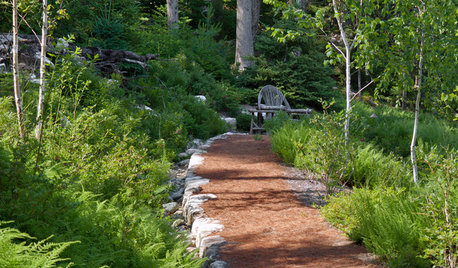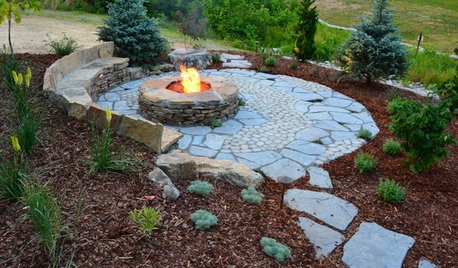Can a wood mulch pile overheat?
studentjo
10 years ago
Featured Answer
Sort by:Oldest
Comments (42)
glib
10 years agoRelated Discussions
Can I use wood chips as mulch?
Comments (12)There are about a gazillion types of ants known to science and probably about two gazillion types they haven't noticed yet. But for the sake of a simple answer, I'll divide them into the three most important types: ants who love wood chips, ants who love plants, and and ants who don't care about either. The ones in the first category love wood chips and/or other dead vegetation for food and/or housing. They may be attracted by wood chips, but most ants in this category are beneficial in breaking down dead vegetation for your vegies to get the nutrients. The ones in the second category use plants for food and/or shelter. Some of these guys "farm" aphids. They may be attracted to your garden by the vegies themselves, regardless of the mulch. The third category will be there regardless of the vegies or mulch. Some of these ants are beneficial hunters of other insects. These categories overlap a bit, but are generally true. The science guys are a lot farther ahead with describing and naming insects, than they are with figuring out how they live and what they eat. If you look in a real deal scientific book on insects, they identify all those tiny red and black ants by things like what their mandibles (jaws) or antennae (feelers) look like when magnified. Just watching them gives you more practical info than going through all that to get a Latin name and no details. Wood chips near the porch may be bad for two reasons. First, the wood chips will shrink a lot as they decompose. second, I've read that they attract termites and carpenter ants, which you don't want damaging your house. My personal experience is that they are only interested in larger pieces of wood that they can create a nest in, and not chips or saw dust. It may be an old wives tale from people seeing carpenter ants in wood chips and/or saw dust where trees were removed and not realizing that they were really living in the stump or underground roots. In your area it may be different though. Ziggy...See Morecitronella ants in a mulch pile - problem?
Comments (1)Like all the other ants, these are part of Ma Natures recycling machine and are more beneficial then harmful. There is no need to be concerned about them, especially since control of ants is more hazardous to you and your environment then leaving them alone would be....See MoreFREE mulch/trimmings for compost pile
Comments (1)Or just call all the wood chippers and tell them if they are in the neighbourhood to drop off the wood chips...They will do it for free as they have to get rid of the wood chips.. Thanks Lyle...See MoreBIG mulch pile
Comments (7)The likelihood of a mulch pile fire is fairly slim, but it does happen. However, it usually happens at composting and recycling facilities with very large piles (often up to 100' wide x 200' long and much taller than your pile). I do a lot of composting in very large piles, often 8' wide x 20-30' long and 6-8' tall at their max when I've just built new piles in autumn. The longest one I've ever had was about 100' long and we stacked old rotting hay bales four high and three deep. It got really hot and steamed and gave me beautiful compost but it never burst into flame (and that pile was new in February or March of 2011 so it certainly could have flamed up in that hot, dry year, especially since I watered it often so a spark wouldn't catch it on fire.) I've never had a fire, but I have had the piles get beautifully steaming hot inside. That sort of heat is caused by decomposition inside the pile, and it peaks pretty quickly and then rapidly dissipates. You might dig into the pile with a shovel and then find white, ashy looking material but it isn't ash---it is from the decomposition of organic matter and often is fungi or other microbial life that is feeding on the decomposing materials. I did consult with my son, who has been a professional firefighter for almost a decade, and his only caution is that if you see flames or smoke (not steam) coming from your pile, then turn on the hose and start wetting it down (if you can safely do so) while dialing 9-1-1. He said the one thing you shouldn't do if you think it is on fire is to take any sort of tool and break open the pile or stir it up, as doing so would allow more oxygen to reach the fire and could cause explosive fire growth. When they fight mulch fires, all they do is pour on massive amounts of water to smother the fire. They don't stir up the pile. The smallest mulch pile fire he can remember was a pile roughly 25' x 50' and it took at least two full days of pouring water on that pile to put it out. Finally, some friends of ours here have had a tree-trimming service dump many truckloads of tree trimming mulch on their property over the years, and it sometimes dumps multiple truck loads in one day, so they end up with really big piles. They've never had a fire. I'm hoping you are as lucky with your mulch pile as they have been with theirs....See MoreTXEB
10 years agoKimmsr
10 years agostudentjo
10 years agoTXEB
10 years agoKimmsr
10 years agostudentjo
10 years agorobertz6
10 years agostudentjo
10 years agoKimmsr
10 years agoTXEB
10 years agoTXEB
10 years agorobertz6
10 years agoTXEB
10 years agoLloyd
10 years agoTXEB
10 years agoLloyd
10 years agoTXEB
10 years agoglib
10 years agochickencoupe
10 years agoflo9
10 years agoKimmsr
10 years agoTXEB
10 years agopnbrown
10 years agoTXEB
10 years agotoxcrusadr
10 years agopnbrown
10 years agopnbrown
10 years agoTXEB
10 years agoflo9
10 years agoTXEB
10 years agopnbrown
10 years agoTXEB
10 years agoglib
10 years agopnbrown
10 years agoTXEB
10 years agotoxcrusadr
10 years agopnbrown
10 years agoTXEB
10 years agoTXEB
10 years agognappi
10 years ago
Related Stories

GARDENING GUIDESThe Art of Green Mulch
You can design a natural garden that doesn’t rely on covering your soil with wood and bark mulch
Full Story
GARDENING GUIDESHow to Pick a Mulch — and Why Your Soil Wants It
There's more to topdressing than shredded wood. Learn about mulch types, costs and design considerations here
Full Story
GARDENING GUIDESNew Ways to Think About All That Mulch in the Garden
Before you go making a mountain out of a mulch hill, learn the facts about what your plants and soil really want
Full Story
GARDENING GUIDES5 Things to Know About Weeding and Mulching Your Native Garden
What’s the best time to pull weeds? How thick should the mulch be? Here’s the scoop for a healthy landscape
Full Story
HOLIDAYS10 Ways Your Christmas Tree Can Live On After the Holidays
Learn how to recycle your Christmas tree and reap benefits for the environment
Full Story
DECORATING GUIDESWhat We Can Learn From the Minimalists
Discover the power of simplicity and how to employ a less-is-more approach in your decorating scheme
Full Story
HOUSEKEEPINGCan-Do Cleaning Strategies for Busy People
While you dream of having a maid (to go with the cook and chauffer), this simplified cleaning routine can keep your real-world home tidy
Full Story
GARDENING GUIDES10 Tips to Start a Garden — Can-Do Ideas for Beginners
Green up your landscape even if you're short on time, money and knowledge, with these manageable steps for first-time gardeners
Full Story
MOST POPULAR9 Real Ways You Can Help After a House Fire
Suggestions from someone who lost her home to fire — and experienced the staggering generosity of community
Full Story
GARDENING GUIDESGarden Myths to Debunk as You Dig This Fall and Rest Over Winter
Termites hate wood mulch, don’t amend soil for trees, avoid gravel in planters — and more nuggets of garden wisdom
Full Story


studentjoOriginal Author